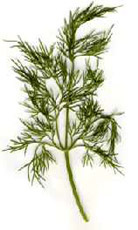 The genus Anethum comprises three species, two of which yield `Dill oil` used in medicines. The two species are:
The genus Anethum comprises three species, two of which yield `Dill oil` used in medicines. The two species are:
1. Anethum graveolens (European Dill): European Dill is indigenous to Europe and is cultivated in England, Germany, Rumania,, Turkey, the USA and Russia. Cultivation in India is tried only recently.
2. Anethum sowa (Indian Dill): The Indian Dill is sometimes regarded as a variety of the European Dill. However, the ripe dried seeds of Indian Dill are longer but less broad than those of European Dill. Their dorsal ridges are paler in color. Composition of essential oil also varies. Indian Dill is a herbaceous umbelliferous annual with pinnately divided
leaves, fond practically throughout India. It is also cultivated as a cold weather crop in
many parts of India. The ripe, light brown seeds emit an aromatic odor faintly resembling
that of caraway.
The physico-chemical analysis Indian Dill seeds are given below:
Moisture: 4.5 to 7.5 % (av. 6.2 %)
Volatile oil: 1.5 to 4.0 % (av. 2.7 %)
Total ash:5.89 to 11.54 % (av. 9.09 %)
Acid insoluble ash:0.55 to 2.71 (av. 1.20 %).
The composition of seeds of European Dill is given below:
Moisture:6.6 %
Protein:13.1 %
Fat:17.9 %
Crude fiber:20.7 %
Carbohydrates:35.7 %
Total ash:6.0 %
Calcium:1.6 %
Phosphorus: 0.21 %
Iron:0.012 %
Potassium:1.1 %
Sodium:0.01 %
Vitamin C (ascorbic acid):12 mg/100g
Vitamin B1:0.42 mg/100g
Vitamin B2:0.28 mg/100g
Niacin:2.8 mg/ 100g
Calorific value: 435 calories/100g
Vitamin A:175 I.U./100 g.
On steam distillation, Indian Dill yields 1.5 to 4.0 % volatile oil, while European Dill grown under Indian conditions yields 2.5 to 4.0 %. Carvone content of two species are different. Indian Dill oil yield 19.5 % while European Dill oil yield 45.9 % Carvone. Therefore quality of oil of European Dill is superior. The method of harvesting and drying significantly affects the yield and quality of the oil.
Dill seeds are used, both whole and ground, as a condiment in soups, salads, processed meats, sausages, spicy table sauces, sauerkraut and particularly in dill pickling. Dill stems and blossom heads are used for dill pickles and for flavoring soups. Ground seed is an ingredient of seasonings. Sometimes it is used as substitute for caraway. The green herb is used as a potherb and a flavoring agent. The essential oil is also used in the manufacture of soaps.
The seeds are well known for their medicinal properties, mostly due to essential oil in them. Both seeds and oil enter into the composition of various indigenous medicinal preparations. The essential oil, Dill oil, or its emulsion in water, Dill water, is considered to be an aromatic carminative especially useful in the flatulence, colic and hiccups of infants and children.
Both the species of Dill is being cultivated in India, each having their own strengths and weaknesses. In either case there is need for application of appropriate post harvesting technology to ensure good quality of final commercial products. For all these operations standard technological know how is available. There are standard driers for drying the seeds and there are standard steam distillation stills for extracting oil. Thus if with all these knowledge and technology, and with implementable schemes around, the plant can be a good input for rural industrialization.
Dill Uses & Benefits
 Dill, as a medicine, has been used as a digestive herb and to induce sleep. Its use has also been claimed to improve vitality and brain power. The ancient Greeks believed that dill cured hiccups. Dill water, made from the Dill seeds, is used to soothe babies. Crushed dill seeds, diluted with water, can be used as a nail-strengthening bath. Dill seeds, when chewed, can highly be effective in curing bad breath.
Dill, as a medicine, has been used as a digestive herb and to induce sleep. Its use has also been claimed to improve vitality and brain power. The ancient Greeks believed that dill cured hiccups. Dill water, made from the Dill seeds, is used to soothe babies. Crushed dill seeds, diluted with water, can be used as a nail-strengthening bath. Dill seeds, when chewed, can highly be effective in curing bad breath.
Dill Dip Recipes - Dill Pickles Recipes
Dill leaves are delicate and add a distinct flavor to salads, seafoods, soups, potatoes, pickles, and butters. The leaves can serve as supplement to vegetable salads.
1. Cucumber, Dill and Lemon Salad
This is a delicious salad to serve with any cold, cooked fish, or with sardines and pilchards.
Ingredients: (Serves 4)
2 tablespoons chopped fresh Dill
2 cucumbers
Juice of one lemon
Olive oil (if liked)
Salt and pepper
Peel and thinly slice cucumbers. Brush lightly with olive oil. Mix together chopped Dill, lemon juice, salt and pepper. Pour over the cucumber slices and toss to mix. Chill before serving. You can also add some small, new potatoes when in season.
2. Mushrooms in Cream and Dill
Ingredients: (Serves 4)
1 tablespoon chopped, fresh Dill
1/2 lb. (1/4 kilos) sliced mushrooms
4 ozs. (120 grams) butter
1/2 cup double cream
Salt and black pepper
Heat the butter in a heavy pan with a cover. When butter is melted add mushrooms and cook over medium heat for 1 minute, stirring occasionally.
Add Dill, and salt and pepper to taste. Cover pan again and cook gently for 5 minutes.
Add cream and simmer, uncovered, until the sauce has thickened slightly. Taste and add more seasoning and Dill if liked. Serve on slices of hot toast.
Botanical Name: Anethum sowa Roxb.
Family Name: Umbelliferae
Indian names are as follows:
Hindi, Bengali, Punjabi and Urdu: Sowa, Soya
Gujarati:Surva
Kannada:Sabasiga
Kashmiri:Soi
Marathi:Surva
Sanskrit:Satapuspi
Tamil:Sathakuppi sompa
Telugu: Sabasige.



